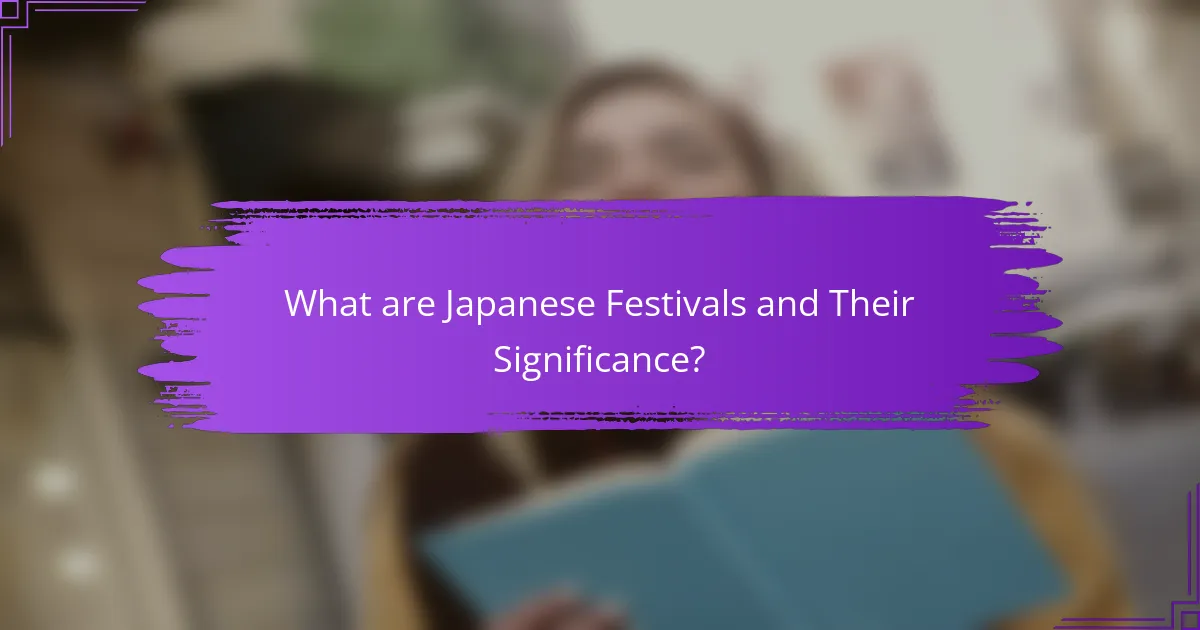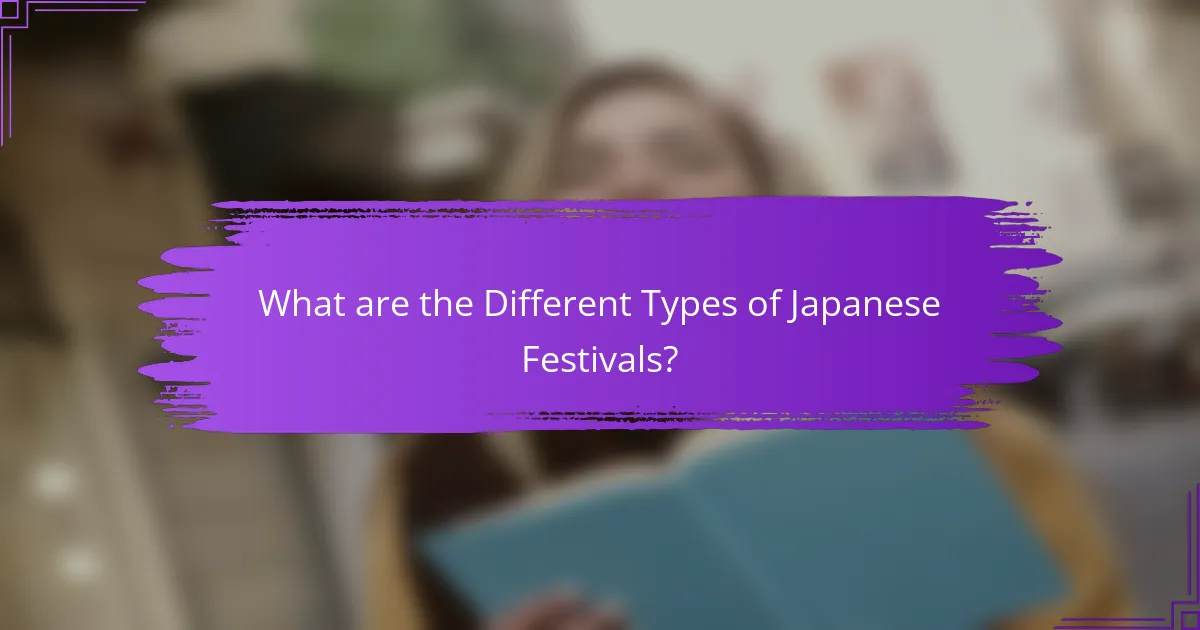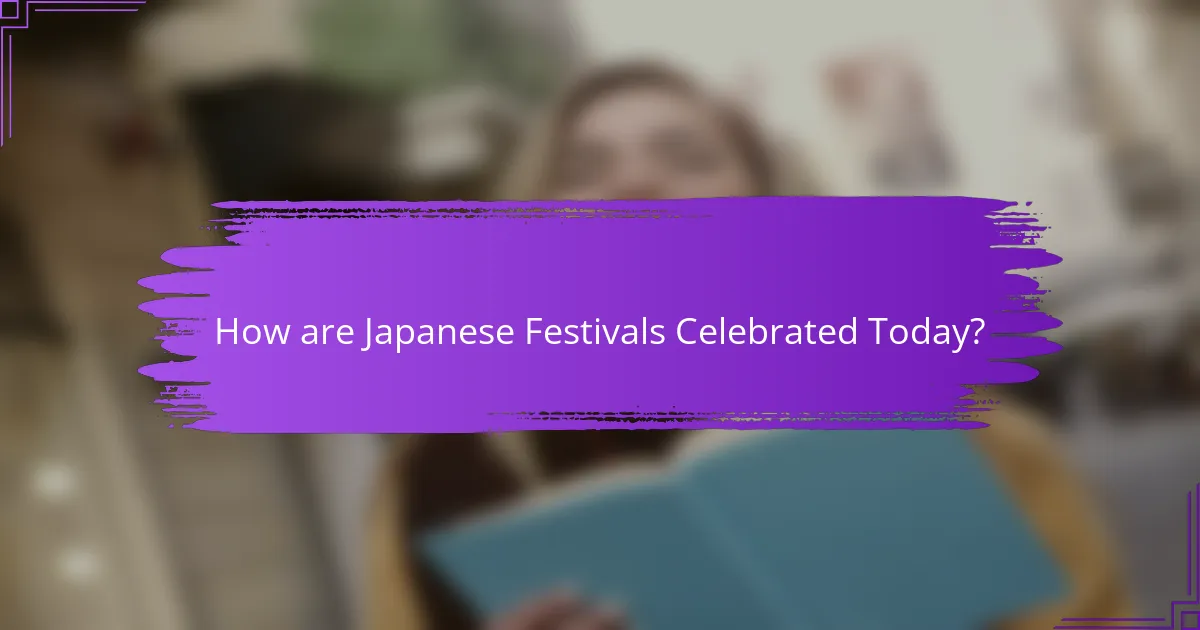
What are Japanese Festivals and Their Significance?
Japanese festivals, known as “matsuri,” are cultural celebrations that often honor deities, seasonal changes, or historical events. These festivals play a crucial role in preserving and promoting Japanese traditions. They include various activities such as parades, traditional music, dance, and food offerings. Festivals often foster community spirit and unity among participants. For example, the Gion Matsuri in Kyoto dates back to the 9th century and celebrates the purification of the city. Such events attract both locals and tourists, contributing to cultural exchange and economic activity. Additionally, festivals serve as a means of spiritual reflection and communal prayer, reinforcing cultural identity.
How do Japanese festivals reflect cultural traditions?
Japanese festivals reflect cultural traditions through their rituals, performances, and communal activities. These festivals often celebrate historical events, seasonal changes, and religious beliefs. For example, the Gion Matsuri in Kyoto honors the gods and showcases traditional floats. Festivals typically feature traditional music, dance, and costumes, which preserve historical practices. Additionally, many festivals involve local community participation, fostering a sense of belonging. The Obon festival, for instance, commemorates ancestors and strengthens family ties. Through these elements, Japanese festivals serve as living expressions of cultural heritage and identity.
What historical events influenced the development of Japanese festivals?
The development of Japanese festivals has been influenced by several historical events. The introduction of rice cultivation during the Yayoi period (300 BC – 300 AD) led to agricultural festivals. These festivals celebrated the rice harvest and honored deities. The arrival of Buddhism in the 6th century brought new rituals and ceremonies. This integration enriched the spiritual aspects of festivals. The Edo period (1603-1868) saw the rise of urban culture. This era popularized seasonal festivals and parades. The Meiji Restoration in 1868 modernized Japan and redefined traditional celebrations. These historical events collectively shaped the diverse landscape of Japanese festivals today.
How do seasonal changes affect the themes of Japanese festivals?
Seasonal changes significantly influence the themes of Japanese festivals. Each season brings unique natural elements that shape the festivals’ focus. For instance, spring festivals often celebrate cherry blossoms, symbolizing renewal and beauty. Summer festivals frequently feature fireworks and traditional dances, reflecting the warmth and vibrancy of the season. Autumn festivals highlight harvests, emphasizing gratitude for bountiful crops. Winter festivals, like the Sapporo Snow Festival, showcase snow and ice sculptures, celebrating the cold climate. These seasonal themes are deeply rooted in Japan’s agricultural traditions and cultural practices. The connection between nature and festivals fosters community involvement and preserves cultural heritage.
What role do festivals play in community involvement?
Festivals play a significant role in fostering community involvement. They bring people together, promoting social interaction and collaboration. Festivals often involve local traditions and cultural expressions, enhancing community identity. Participation in organizing and attending festivals strengthens bonds among residents. According to a study by the National Endowment for the Arts, community festivals can increase civic engagement. They provide opportunities for local businesses to thrive through increased foot traffic. Festivals also encourage volunteerism, as many community members contribute their time and skills. Overall, festivals serve as a catalyst for community cohesion and active participation.
How do festivals foster community spirit and togetherness?
Festivals foster community spirit and togetherness by bringing people together in a shared experience. They create opportunities for social interaction among diverse groups. Participants engage in traditional activities that promote cultural heritage. Festivals often include music, dance, and food, enhancing the communal atmosphere.
These events encourage collaboration through volunteer efforts in planning and execution. Community members bond over shared responsibilities and goals. Festivals also strengthen local identity, fostering pride among residents. According to a study by the National Endowment for the Arts, community festivals significantly increase social cohesion and civic engagement.
What opportunities do festivals provide for local businesses?
Festivals provide significant opportunities for local businesses. They increase foot traffic in the area, leading to higher sales. Local vendors can showcase their products to a larger audience. This exposure can result in new customer relationships. Festivals also encourage collaboration among businesses. They often create partnerships for promotions and events. According to a study by the National Endowment for the Arts, festivals can boost local economies by up to 30%. This economic impact supports job creation and community development.

What are the Different Types of Japanese Festivals?
Japanese festivals, known as “matsuri,” can be categorized into several types. These include religious festivals, seasonal festivals, and community festivals. Religious festivals often celebrate Shinto or Buddhist traditions. Seasonal festivals mark events like harvests or the changing of seasons. Community festivals focus on local culture and traditions. Each type serves to strengthen community bonds and preserve cultural heritage. Festivals often feature traditional music, dance, and food. They attract both locals and tourists, contributing to cultural exchange. The diversity of festivals reflects Japan’s rich cultural landscape.
What are the major categories of Japanese festivals?
The major categories of Japanese festivals include Shinto festivals, Buddhist festivals, seasonal festivals, and local community festivals. Shinto festivals, or Matsuri, celebrate deities and seasonal changes. They often feature rituals, processions, and traditional music. Buddhist festivals commemorate significant events in Buddhism, such as Obon, honoring deceased ancestors. Seasonal festivals celebrate agricultural cycles, like rice planting or harvest. Local community festivals focus on regional traditions and often involve parades, food stalls, and games. Each category reflects Japan’s rich cultural heritage and community spirit.
How do religious festivals differ from seasonal celebrations?
Religious festivals focus on spiritual significance and commemorate specific beliefs or deities. These festivals often include rituals, prayers, and ceremonies unique to a religion. For example, Shinto festivals in Japan celebrate kami, or spirits, through offerings and traditional dances.
Seasonal celebrations, on the other hand, are tied to natural cycles and agricultural practices. They mark changes in seasons or harvests, like the Japanese festival of Hanami, which celebrates cherry blossoms.
While both types of celebrations foster community and cultural identity, their core purposes differ. Religious festivals emphasize faith and worship, whereas seasonal celebrations highlight nature and seasonal changes.
What are some examples of prominent Japanese festivals?
Prominent Japanese festivals include Gion Matsuri, Tanabata, and Aoi Matsuri. Gion Matsuri is held in Kyoto every July and features elaborate floats. It dates back to the 9th century, celebrating the purification of the city. Tanabata, celebrated in July, honors the meeting of two stars and involves writing wishes on colorful strips of paper. Aoi Matsuri takes place in May and is one of Kyoto’s oldest festivals, showcasing traditional Heian period costumes. Each festival reflects unique cultural practices and community involvement throughout Japan.
What unique attributes do specific festivals possess?
Specific festivals possess unique attributes such as regional significance, traditional practices, and distinct rituals. Regional significance highlights the local culture and history tied to the festival. Traditional practices often include age-old customs that have been passed down through generations. Distinct rituals may involve specific ceremonies, performances, or offerings unique to each festival. For example, the Gion Matsuri in Kyoto features elaborate floats and processions that are not found in other festivals. Similarly, the Nebuta Matsuri in Aomori showcases illuminated floats depicting historical figures. These attributes contribute to the festivals’ identity and community engagement.
How does the Gion Matsuri showcase Kyoto’s cultural heritage?
The Gion Matsuri showcases Kyoto’s cultural heritage through its rich traditions and historical significance. It is celebrated annually in July, originating from a purification ritual in 869 AD. The festival features elaborate floats called “yamaboko,” which are intricately designed and represent various neighborhoods. Each float is adorned with traditional crafts, showcasing Kyoto’s artistry. The event includes processions, music, and dance, reflecting the community’s involvement and cooperation. The Gion Matsuri also emphasizes Shinto beliefs, linking local deities to the city’s history. This festival attracts both locals and tourists, promoting cultural exchange and awareness of Kyoto’s heritage.
What makes the Nebuta Matsuri of Aomori distinct?
The Nebuta Matsuri of Aomori is distinct due to its large, illuminated floats known as “nebuta.” These floats depict historical figures and scenes from mythology. The festival features vibrant colors and intricate designs that captivate thousands of spectators. Participants, called “haneto,” wear traditional costumes and dance to lively music. The event occurs annually in early August, attracting over 3 million visitors. It has roots in a 7th-century tradition related to the Obon festival. The Nebuta Matsuri is recognized as an Important Intangible Folk Cultural Asset by the Japanese government. This unique combination of art, culture, and community spirit sets it apart from other Japanese festivals.

How are Japanese Festivals Celebrated Today?
Japanese festivals are celebrated today with a blend of traditional practices and modern influences. These events often feature colorful parades, traditional music, and dance performances. Many festivals, such as Gion Matsuri in Kyoto, include elaborate floats and processions. Participants often wear traditional attire like yukatas and kimonos. Food stalls offering local delicacies are common at these celebrations. Community involvement is crucial, with local residents organizing events and activities. Festivals also serve to strengthen community bonds and cultural identity. In recent years, festivals have adapted to include digital elements and online participation, broadening their reach. This evolution reflects both preservation of heritage and adaptation to contemporary society.
What modern practices have emerged in Japanese festivals?
Modern practices in Japanese festivals include the incorporation of technology and social media. Many festivals now utilize live streaming to reach broader audiences. This allows those unable to attend in person to participate virtually. Additionally, festivals have adopted digital payment systems for convenience. Food stalls and vendors often accept mobile payments, enhancing the overall experience. There is also a growing trend of themed festivals that cater to specific interests, such as anime or food. These attract diverse crowds and promote cultural exchange. Furthermore, sustainability practices are becoming more common. Many festivals are now focusing on reducing waste and promoting eco-friendly initiatives. These modern adaptations reflect changing societal values and enhance community engagement.
How do technology and social media influence festival participation?
Technology and social media significantly enhance festival participation. They provide platforms for event promotion and information sharing. Social media allows organizers to reach a broader audience quickly. According to a study by Eventbrite, 93% of event organizers use social media for marketing. Real-time updates on platforms like Twitter and Instagram keep attendees informed. Technology also facilitates ticket sales through online platforms. This convenience increases attendance rates. Furthermore, social media fosters community engagement before, during, and after events. Participants share experiences, creating a sense of belonging.
What adaptations have festivals made in response to global events?
Festivals have adapted by incorporating virtual components in response to global events. Many festivals transitioned to online formats to reach wider audiences. This adaptation allowed participation from people unable to attend physically. Health and safety measures were also implemented, including social distancing protocols. Some festivals reduced attendance numbers to comply with regulations. Others extended their duration to allow staggered participation. Hybrid models emerged, combining in-person and virtual experiences. These changes ensured that cultural traditions continued despite global disruptions.
What are the best practices for participating in Japanese festivals?
To participate in Japanese festivals effectively, understanding cultural etiquette is essential. Dress appropriately, often in traditional attire like yukata. Respect local customs and follow the crowd’s lead in activities. Engage with festival vendors and try local foods to enhance the experience. Be mindful of the festival schedule to not miss key events. Arrive early to secure a good viewing spot for parades or performances. Familiarize yourself with the festival’s history to appreciate its significance. Lastly, show gratitude to organizers and participants to foster community spirit. These practices ensure respectful and enjoyable participation in Japanese festivals.
How can visitors respectfully engage with local traditions during festivals?
Visitors can respectfully engage with local traditions during festivals by observing and following cultural norms. Understanding the significance of rituals is essential. Participating in traditional activities, such as dances or ceremonies, shows respect. Dressing appropriately for the occasion demonstrates awareness of local customs. Asking locals for guidance fosters positive interactions. Avoiding disruptive behavior is crucial to maintaining the festival’s atmosphere. Learning a few key phrases in the local language can enhance communication. Respecting sacred spaces and traditions is important for honoring the community’s values. Engaging with locals helps visitors gain deeper insights into the culture.
What tips can enhance the festival experience for newcomers?
To enhance the festival experience for newcomers, it is essential to plan ahead. Research the festival schedule and map out key events. Arriving early can help newcomers avoid crowds and find the best spots. Engaging with locals can provide insights and tips about the festival. Sampling local food and participating in traditional activities enriches the experience. Wearing comfortable clothing and shoes is crucial for long hours of walking and standing. Staying hydrated and taking breaks ensures newcomers maintain their energy throughout the festival. Lastly, being open to new experiences fosters a positive atmosphere and encourages interaction with fellow festival-goers.
The main entity of the article is Japanese festivals, known as “matsuri,” which are cultural celebrations that honor deities, seasonal changes, and historical events. The article explores the significance of these festivals in preserving cultural traditions, fostering community involvement, and promoting local economies. It categorizes festivals into religious, seasonal, and community types, highlighting examples such as Gion Matsuri and Nebuta Matsuri. Additionally, the article discusses the impact of modern practices, technology, and social media on festival participation, while providing insights on best practices for respectful engagement during these events.